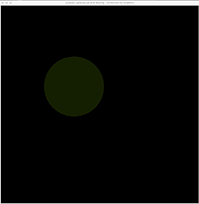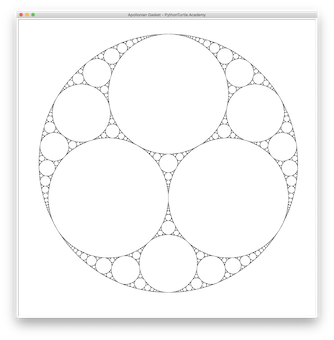This tutorial explains how to implement gradually lighting up and moving animation. This is a continuation of gradually lighting up animation tutorial. So, please make sure you read it before continuing on this one. This is part of a series of tutorials leading up to the implementation of synchronized fireflies.
In this project, the object is not only lighting up it is also moving randomly. To achieve this we must add a few more state variables besides current time and brightness values. We will add current position and target position variables. Target position is set randomly. The object will move towards the target position at a constant speed. When the object reaches or get close enough to the target, we will create a new target repeat the same process.
The following code is the model only part of the project. Since there are two independent states to update, we created two functions: update_brightness() and update_position(). The main update_states() function calls these two functions. Function update_brightness() works exactly the same as before. Function update_position() gets the direction from the current position to the target position and move SPEED*(1/FPS) steps because the the elapsed time for each update_position() call is about 1/FPS second. When the object gets close enough to the target, we will randomly generate a new target. Don’t set threshold for close enough to a very small number. Because of errors in floating point computation along with discrete time in updating the position, the object may never get as close to the tiny distance.
import turtle
import colorsys
import random
import math
screen = turtle.Screen()
screen.setup(1000,1000)
screen.title("Gradually Lighting Up and Moving - PythonTurtle.Academy")
turtle.hideturtle()
turtle.speed(0)
turtle.tracer(0,0)
# Constants
H_YELLOWGREEN = 0.22 # constant: hue value of yellow green color.
V_DARK = 0.1 # constant: brightness value of initial dark state
V_BRIGHT = 1 # constant: brightness value of the brightest state
FPS = 30 # constant: refresh about 30 times per second
TIMER_VALUE = 1000//FPS # the timer value in milliseconds for timer events
CYCLE = 5 # costant: 5 second cycle for firefly to light up
LIGHTUP_TIME = 1 # constant: 1 second light up and dim
SPEED = 100 # 100 units per second
CLOSE_ENOUGH = 16 # if distance squared to target is less than 16, then it is close enough.
# make sure that this number is greater than SPEED/FPS squared
# Variables
v = V_DARK # initial brightness state
t = 0 # current time
current_xpos = 0 # current x coordinate
current_ypos = 0 # current y coordinate
target_xpos = random.randint(-300,300) # target x coordinate, random location
target_ypos = random.randint(-300,300) # target y coordinate, random location
def update_brightness():
global t,v
if t > CYCLE:
t -= CYCLE # make sure time stays within CYCLE
if t < CYCLE-LIGHTUP_TIME:
v = V_DARK # dormant period
elif t < CYCLE-LIGHTUP_TIME/2: # gradually (linearly) lighting up period
v = V_DARK + (V_BRIGHT-V_DARK)*(t-(CYCLE-LIGHTUP_TIME))/(LIGHTUP_TIME/2)
else: # gradually (linearly) dimming period
v = V_BRIGHT - (V_BRIGHT-V_DARK)*(t-(CYCLE-LIGHTUP_TIME/2))/(LIGHTUP_TIME/2)
def update_position():
global current_xpos,current_ypos,target_xpos,target_ypos
# move towards target SPEED/FPS steps
# figure out angle to target first
angle_to_target = math.atan2(target_ypos-current_ypos,target_xpos-current_xpos)
# compute changes to current position based on the angle and distance to move per 1/FPS second.
current_xpos += SPEED/FPS*math.cos(angle_to_target)
current_ypos += SPEED/FPS*math.sin(angle_to_target)
print(current_xpos,current_ypos,target_xpos,target_ypos)
# check to see if close enough to target.
dist_to_target_squared = (current_xpos-target_xpos)**2 + (current_ypos-target_ypos)**2
if dist_to_target_squared < CLOSE_ENOUGH: # close enough, set new target
target_xpos = random.randint(-300,300) # target x coordinate, random location
target_ypos = random.randint(-300,300) # target y coordinate, random location
def update_states():
global t
t += TIMER_VALUE/1000 # every time this function is called, time increases by this value
update_brightness()
update_position()
screen.ontimer(update_states,TIMER_VALUE)
screen.ontimer(update_states,TIMER_VALUE)
After completing the model part, the rest is extremely easy. The following is the complete code for this project. Because the object is constantly moving, the should_draw value is set to True every time update_state() function is called.
import turtle
import colorsys
import random
import math
screen = turtle.Screen()
screen.setup(1000,1000)
screen.title("Gradually Lighting Up and Moving - PythonTurtle.Academy")
turtle.hideturtle()
turtle.speed(0)
turtle.tracer(0,0)
screen.bgcolor('black')
firefly = turtle.Turtle() # turtle for drawing the lighting dot
firefly.hideturtle()
firefly.up()
# Constants
H_YELLOWGREEN = 0.22 # constant: hue value of yellow green color.
V_DARK = 0.1 # constant: brightness value of initial dark state
V_BRIGHT = 1 # constant: brightness value of the brightest state
FPS = 30 # constant: refresh about 30 times per second
TIMER_VALUE = 1000//FPS # the timer value in milliseconds for timer events
CYCLE = 5 # costant: 5 second cycle for firefly to light up
LIGHTUP_TIME = 1 # constant: 1 second light up and dim
SPEED = 100 # 100 units per second
CLOSE_ENOUGH = 16 # if distance squared to target is less than 16, then it is close enough.
# Variables
v = V_DARK # initial brightness state
t = 0 # current time
current_xpos = 0 # current x coordinate
current_ypos = 0 # current y coordinate
target_xpos = random.randint(-300,300) # target x coordinate, random location
target_ypos = random.randint(-300,300) # target y coordinate, random location
should_draw = True # this variable is used to decide if drawing is necessary to save CPU time
def update_brightness():
global t,v
if t > CYCLE:
t -= CYCLE # make sure time stays within CYCLE
if t < CYCLE-LIGHTUP_TIME:
v = V_DARK # dormant period
elif t < CYCLE-LIGHTUP_TIME/2: # gradually (linearly) lighting up period
v = V_DARK + (V_BRIGHT-V_DARK)*(t-(CYCLE-LIGHTUP_TIME))/(LIGHTUP_TIME/2)
else: # gradually (linearly) dimming period
v = V_BRIGHT - (V_BRIGHT-V_DARK)*(t-(CYCLE-LIGHTUP_TIME/2))/(LIGHTUP_TIME/2)
def update_position():
global current_xpos,current_ypos,target_xpos,target_ypos
# move towards target SPEED/FPS steps
# figure out angle to target first
angle_to_target = math.atan2(target_ypos-current_ypos,target_xpos-current_xpos)
# compute changes to current position based on the angle and distance to move per 1/FPS second.
current_xpos += SPEED/FPS*math.cos(angle_to_target)
current_ypos += SPEED/FPS*math.sin(angle_to_target)
#print(current_xpos,current_ypos,target_xpos,target_ypos)
# check to see if close enough to target.
dist_to_target_squared = (current_xpos-target_xpos)**2 + (current_ypos-target_ypos)**2
if dist_to_target_squared < CLOSE_ENOUGH: # close enough, set new target
target_xpos = random.randint(-300,300) # target x coordinate, random location
target_ypos = random.randint(-300,300) # target y coordinate, random location
def update_states():
global t,should_draw
t += TIMER_VALUE/1000 # every time this function is called, time increases by this value
update_brightness()
update_position()
should_draw = True
screen.ontimer(update_states,TIMER_VALUE)
def draw():
global v,firefly,should_draw,current_xpos,current_ypos
if should_draw == False: # There is no change. Don't draw and return immediately
return
firefly.clear() # clear the current drawing
color = colorsys.hsv_to_rgb(H_YELLOWGREEN,1,v) # use colorsys to convert HSV to RGB color
firefly.color(color)
firefly.goto(current_xpos,current_ypos)
firefly.dot(200)
should_draw = False # just finished drawing, set should_draw to False
screen.ontimer(update_states,TIMER_VALUE)
while True:
draw() # draw forever
screen.update()
Related Tutorials:




